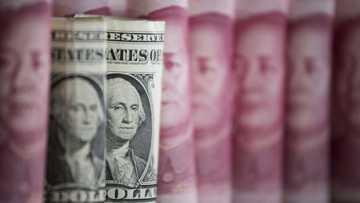How are cocoa prices set in the world market?
When you bite into a chewy chocolate bar or take a cup of hot chocolate, you are at one end of the cocoa trade. The price of chocolate tends to rise year-on-year, but that is not the same for the cheaper cost of cocoa in the world market. This leads to massive profits for companies that dominate the chocolate market, but cocoa-producing countries and farmers, in particular, do not enjoy price stability. That raises a fundamental question - how are cocoa prices set?

Source: Getty Images
Every year, the price of cocoa tends to be unpredictable. Between 2016 and 2019, the monthly price for the commodity peaked in mid-2016 to about $3,122 per metric ton. However, it declined to $2,134 in October 2018. So, how are cocoa prices set or what factors drive the price of this cash crop?
Factors that affect the price of cocoa
The price of cocoa in the world market depends on various factors. Some of these can be controlled by farmers while others are beyond their control. Overall, the corporations involved in buying and selling of cocoa determine the final prices. With that in mind, prices fluctuate due to these factors:
1. London Cocoa Futures
For many years, the London Cocoa Futures contract has been the benchmark for the pricing of physical cocoa. Chocolate processors, trade houses, producers, exporters, and other investors use the standard to trade the commodity in the global market.
The Cocoa contract is also the benchmark for the global cocoa market. It prices the physical delivery of exchange-grade product from cocoa-producing countries.
2. Geopolitics
Ghana and Ivory Coast play a central role in the cocoa market. The two countries are the largest producers of the cash crop in the world, contributing to about two-thirds of the commodity.

Source: Getty Images
In June 2019, the two West African nations halted the sales of cocoa beans and demanded a new minimum price of $2,600 per metric ton for farmers. The effect of such an announcement is it complicates the price determination by traders. As a result, it causes a price rally on the futures market.
3. Value of the British Pound and US Dollar
The value of the British Pound and US Dollar determine the price of cocoa because both currencies dominate the commodity. But of the two currencies, the British Pound has a direct correlation because London is the location where the physical trading of cocoa happens. Thus, an increase in the value of the pound increases cocoa prices while a decrease lowers it.
4. Supply and Demand
Changes in supply and demand nudge the price of raw cocoa either downward or upward. A collapse in demand for the commodity tends to lower its cost. Furthermore, increasing demand for cocoa seeds from markets like China and BRICs, coupled with a complicated set of facts on the supply side of the commodity affects the pricing of cocoa.
5. Overproduction
The overproduction of cocoa affects its price negatively. When farmers are producing too much of the commodity, prices drop sharply. This is because there is more cocoa being sold than buyers need. They are, therefore, able to negotiate for lower prices.
6. Weather
Weather conditions play a significant role in the pricing of cocoa. The production of the commodity requires specific weather patterns, both in rainfall and temperature. Global warming can affect cocoa farmers and general supply.
What is the world market price for cocoa?

Source: Getty Images
As of 7 December 2020, the cocoa futures end of day settlement price was $2,636.00 per metric ton. Cocoa beans daily price on 13 November 2020 closed at $2,238.41 per metric ton. The cocoa price forecast shows that the commodity will increase in value in 2021 as the demand for cocoa increases, and both Ghana and Ivory Coast experience some political stability after elections.
According to Wallet Investor, players in the industry should expect a long-term increase in its price to around $3,163.540 per Metric Ton in 2025.
Why is cocoa so expensive?
Cocoa is expensive because of the following factors:
- A limited supply of cocoa beans and high demand for the commodity.
- The rate of increase in cocoa production has been slowing over the years, as cocoa trees have been responding to the changing weather patterns, also known as climate change.
- Low supply of the cash crop.
After Ivory Coast and Ghana increased the minimum price per metric ton of cocoa by $400, it has made the commodity expensive. But why are cocoa farmers paid so little?
The factors that make cocoa farmers earn little money from their produce include:
- Many of them live in poverty and do not have an organisation or cooperative that can represent them and their interests.
- The cocoa market has seen mergers and takeovers that have resulted in a few companies controlling the sector. The consolidation in the cocoa supply chain has played a significant role in the prices of the commodity.
- The sustainability efforts put forward by cocoa-producing countries and corporations focus on farmer’s productivity instead of looking at how to increase the prices of the commodity for farmers.
- Most farmers are earning less than $2 per day. A low income means they are unable to invest in their farms or access fertiliser and other planting materials.
Furthermore, low yields because of poor farming practices, limited access to farming inputs, and ageing trees are other factors that have contributed to low earnings.
How much do cocoa farmers get paid?

Source: UGC
Within the cocoa supply chain, farmers are among the lowest earners. Whenever industry players sell a tonne of the commodity, farmers only earn 6.6% of the value of the final sale. The cocoa and chocolate industries can suffer shortages if farmers cut down their cocoa trees. But at present, there is little effort in influencing prices in favour of the farmer.
How much does a cocoa farmer make per day?
Since farmers earn 6.6% of the value of the final sale, many of them make as little as 23p ($0.31) per day. The amount is below the extreme global poverty line of £1.40 ($1.87) a day, and an average farmer pay rate of 75p ($1) a day.
Which international corporations dominate the chocolate trade?
According to Statista, Mars, Mondez International, Nestle, Ferrero, Hershey, and Chocoladefabriken Lindt & Sprungli are the international corporations that dominate the chocolate trade and cocoa industry. As of 2016, the six companies have a combined market share of 60.1%. Mars alone controls 14.4% of the global chocolate market, making it the largest chocolate company in the world.
So, how are cocoa prices set? The London Cocoa futures contract is the benchmark for the pricing of physical cocoa and the global cocoa market. But several things also affect the price of the commodity, including geopolitics, weather, supply and demand, and overproduction. Despite farmers putting a lot of effort into the production of raw cocoa, they only earn 6.6% of the value f the final sale.
Yen.com.gh recently published a piece on the largest cocoa-growing districts in Ghana. As the world’s largest cocoa producer, it is easy to assume that cocoa is grown in every region in Ghana. This is not the case.
Cocoa is mostly cultivated in 6 major regions in Ghana. Learn more about these regions and what exactly makes them ideal for growing cocoa.
Source: YEN.com.gh







